Monster of the Mining
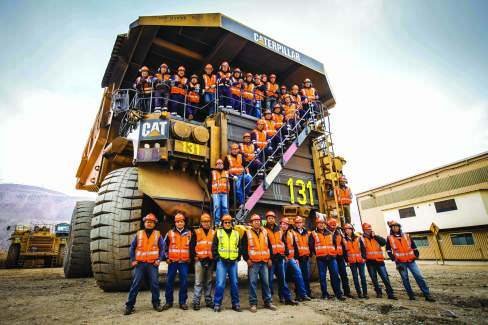
To obtain additional information about the importance of these equipment it is necessary to know that "a large mining truck currently costs around US $ 4 million, it takes at least two years to be operational in the mine after having placed your purchase order" it is feasible to lease them) and have a useful life of around 15 years. "The market share of large off-highway trucks is: 50% Caterpillar 52%, Komatsu 44% and Liebherr with 4%.
Given the importance of these equipment, the purchase decisions of a truck are critical, must be made well in advance, as these will influence for many years in its operation and maintenance and even affect the design of a pit mine.
In practice, it is the design of mine tracks that defines the shape of the final mine, this means that depending on the dimensions and safety features and maneuverability of these units, more or less wide ramps will be required. and more or less pronounced. What significantly affects the angle of the final pit and therefore, the sterile-ore ratio. Being the largest trucks (given the tendency to gigantism on the part of the industry), they have a lower capacity to adapt to forms more adjusted to the mathematical modeling made by current mining software.
Just as the truck industry has tended to gigantism, it has also sought greater autonomy for these vehicles. However, greater size implies lower speeds, requirement of more space in the ramps in addition to a purchase or lease more difficult and long to manage, among other aspects.
**
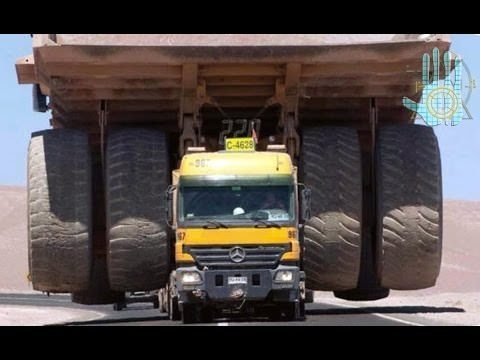
According to a study by Professor John Meech of Columbia University, autonomous trucks have an impact on an increase in production between 15% and 20%; in decrease of fuel consumption between 5% and 15%; similar figures for tire wear; increase in utilization close to 10%; and a maintenance cost of less than 8%.
However, the professor warns that a higher production and compliance of short-term indicators does not mean a higher value of the business. "Therefore, from the quantitative point of view, there is no certainty of which system is better" whether the manual or the self-employed.
The industry has been exceeding the threshold in the ratio of material movement versus weight of the truck, another challenge is to reduce the transport cycle of trucks, for example, increasing the speed of the truck loaded on a slope, currently between 10 km / hr at 13 km / hr, there are several companies that specialize in designing lighter truck hoppers without sacrificing their resistance, which allow them to move more material, which multiplied by the number of trips a truck makes means a significant reduction in costs .
Below are the five largest rock trucks in the world:
1. The Belaz 75710:
With a load capacity of 496 tons, it is the largest dumper in the world. The model was developed by the engineers of the Belarusian company Belaz in October 2013, under a major order for a Russian mining company.
The truck has a length of 20.6 m, a height of 8.16 m, a width of 9.87 m, a curb weight of 360 t and eight large Michelin tires without a camera. The vehicle integrates two diesel engines with turbocharger of 16 cylinders, with a power of 2,332 CV each one that allow to reach a maximum speed of 64 km / h, using an electromechanical transmission driven by alternating current.
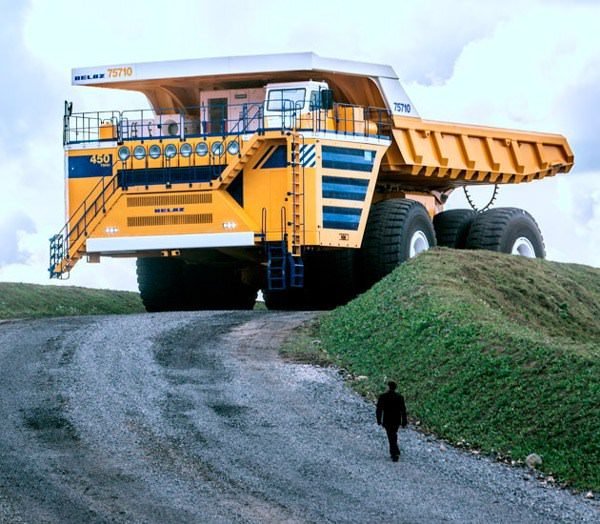
2. Caterpillar 797F:
The Caterpillar 797F is the latest model of the 797 series manufactured and developed by Caterpillar engineers, currently ranking as the second largest in the world, present in the market since 2009. This huge vehicle can transport 400 tons of cargo Useful,
The dumper truck has an operating gross weight of 687.5 t, with dimensions that reach 14.8 m in length, 6.52 m in height and 9.75 m in width. Likewise, it is equipped with six Michelin XDR or Bridgestone VRDP radial tires, as well as a C175-20 diesel engine with four-stroke turbocharger and a hydraulic torque converter transmission, allowing it to operate at a maximum speed of 68 km / h.
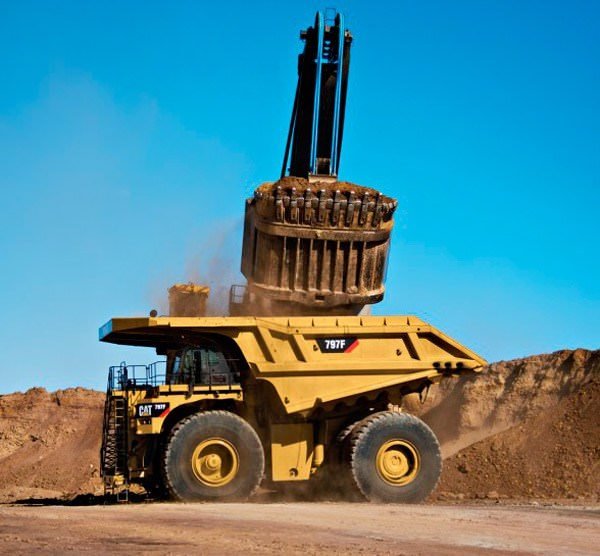
3. Terex MT 6300AC:
The Terex MT 6300AC, introduced to the market in 2008 by the engineers of the American manufacturer Terex, is placed third in our classification with a load capacity of 400 tons, tying with the Caterpillar 797F.
The operative gross weight of the vehicle is about 660 tons, reaching a length of 14.63 m and a height of 7.92 m. The dumper is equipped with a diesel engine of 20 cylinders of four times, with electric alternator of AC, which in turn supplies power to the electric motor mounted on each side of the rear axle. The power of the engine exceeds 3,750 hp, and can work at a maximum speed of 64 km / h.
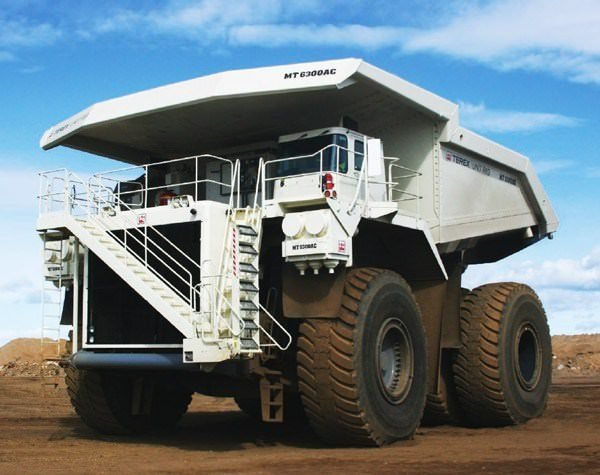
4. Liebherr T 282C
The Liebherr T 282C, are two dumpers with payload capacity of 400 tons designed and manufactured by Liebherr engineers. The trucks share the distinction of being the second largest in the world with the Caterpillar 797F and Terex MT 6300AC. Specifically, the T 282C of Liebherr is the successor of the T 282B with a capacity of 360 t.
The gross weight of both the T 282C are exactly the same, 661 tons. The total length of these dumpers reaches 15.69 m, having a total width of 9.67 m and a height of 7.42 m. The vehicles are equipped with a diesel engine of 20 cylinders with a power of up to 3,750 HP, which allow speeds of 64 km / h.
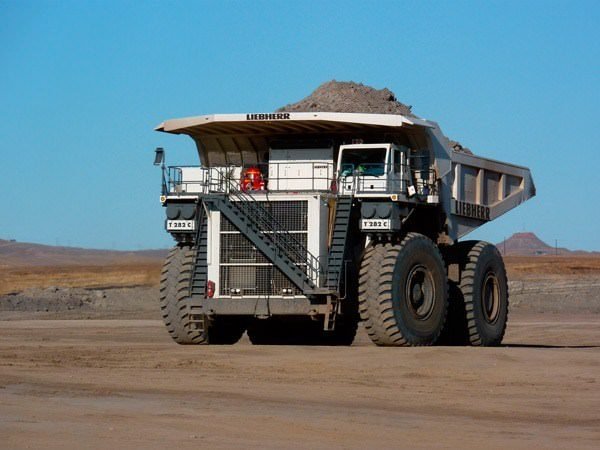
5. Belaz 75601:
The Belaz 75601 has the capacity to transport up to 396 tons of payload, ranking fifth in our classification. Specifically, it is the latest model of class 7560, designed by Belaz engineers to transport the material from deep open-cast mines supporting all types of weather conditions.
The operative gross weight of the vehicle reaches 672.4 tons, with a length of 14.9 m, a width of 9.25 m and a height of 7.22 m. The truck dumper uses the electromechanical transmission with a diesel engine of four times of 20 cylinders of type V, with a power of 3.750 CV that allow him to reach maximum speeds of 64 km / h.
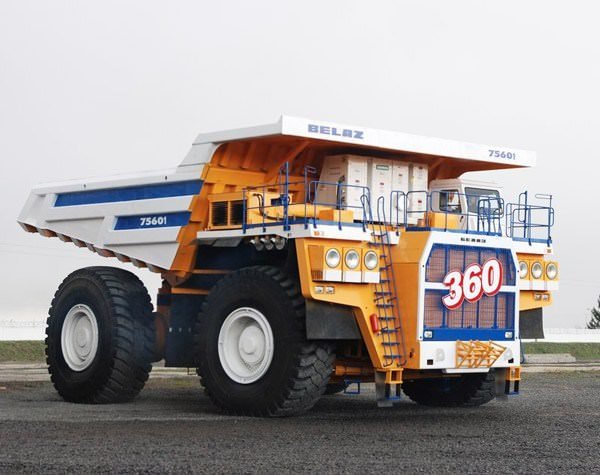
I hope you have liked this little post of mining see you in the next
Ing. Yondert A Melo.
En la actualidad el mundo moderno no puede concebirse sin la minería y para satisfacer la creciente demanda de minerales, la industria de la ingeniería debe estar en constante renovación y diseño de las capacidades de los equipos empleados para el transporte y procesamiento de los minerales de todo el mundo, en esta oportunidad les presento a la comunidad de steemians un pequeño paseo por estas colosales bestias que transitan las vialidades de las minas de todo el mundo.
Para tener un primer acercamiento a la importancia de estos equipos es necesario saber que “un camión grande en minería cuesta actualmente en torno a US$4 millones, demora al menos dos años en estar operativo en mina después de haber puesto su orden de compra (también es factible arrendarlos) y tienen una vida útil en torno a 15 años”. La participación de mercado de los camiones grandes fuera de carretera (sobre 50 ton de capacidad) es la siguiente: Caterpillar 52%, Komatsu 44% y Liebherr con el 4%.
Dada la importancia de estos equipos, las decisiones de compra de un camión son críticas, deben realizarse con mucha anticipación, ya que estas influirán durante muchos años en su operación y mantenimiento y llega a incidir en el diseño de un pit minero.
En la práctica, es el diseño de las vías de una mina lo que define la forma de la de mina final, esto quiere decir que dependiendo de las dimensiones y características de seguridad y maniobrabilidad que tengan estas unidades, se requerirá rampas más o menos anchas y más o menos pronunciadas. Lo que afecta notablemente el ángulo del pit final y por tanto, la razón estéril-mena. Al ser los camiones más grandes (dada la tendencia al gigantismo por parte de la industria), tienen una menor capacidad de acomodarse a formas más ajustadas a los modelajes matemáticos realizados por software mineros actuales.
Así como la industria de los camiones ha tendido al gigantismo, también ha buscado una mayor autonomía de estos vehículos. Sin embargo, mayor tamaño implica menores velocidades, requerimiento de mayor espacio en las rampas además de una compra o arriendo más difícil y largo de gestionar, entre otros aspectos.
Según un estudio del profesor John Meech, de la Universidad de Columbia, los camiones autónomos impactan en un aumento de la producción entre un 15% a un 20%; en disminución del consumo de combustible entre un 5% y un 15%; cifras similares para el desgaste de neumáticos; aumento de la utilización cercana al 10%; y un costo de mantenimiento inferior al 8%.
Sin embargo, el profesor advierte que una mayor producción y cumplimiento de indicadores de corto plazo no equivale a un mayor valor del negocio. “Por tanto, desde el punto de vista cuantitativo, no hay certeza de cuál sistema es mejor” si el manual o el autónomo.
La industria ha ido superando el umbral en la relación cantidad de movimiento de material versus peso del camión, otro desafío se centra en disminuir el ciclo de transporte de los camiones, por ejemplo, aumentando la velocidad del camión cargado en pendiente, actualmente entre 10 km/hr a 13 km/hr, existen varias empresas especializadas en diseñar tolvas de camiones más livianas sin sacrificar su resistencia, que permitan trasladar mayor cantidad de material, lo que multiplicado por el número de viajes que realiza un camión supone una importante reducción de costos.
A continuación se presentan los cinco camiones roqueros más grandes del mundo:
- El Belaz 75710:
Con una capacidad de carga de 496 toneladas, es el mayor dumper del mundo. El modelo fue desarrollado por los ingenieros de la compañía bielorrusa Belaz en octubre de 2013, en virtud de un importante pedido para una empresa minera rusa.
El camión cuenta con una longitud de 20,6 m, una altura de 8,16 m, un ancho de 9,87 m, un peso en vacío de 360 t y ocho neumáticos Michelin de gran tamaño sin cámara. El vehículo integra dos motores diésel con turbocompresor de 16 cilindros, con una potencia de 2.332 CV cada uno que permiten alcanzar una velocidad máxima de 64 km/h, utilizando una transmisión electromecánica accionada por corriente alterna. - Caterpillar 797F:
El Caterpillar 797F es el último modelo de la serie 797 fabricados y desarrollados por los ingenieros de Caterpillar, posicionándose en la actualidad como el segundo más grande del mundo, presente en el mercado desde el año 2009. Este enorme vehículo puede transportar 400 toneladas de carga útil,
El camión dumper tiene un peso bruto operativo de 687,5 t, con unas dimensiones que alcanzan los 14,8 m de longitud, 6,52 m de altura y 9,75 m de ancho. Asimismo, está equipado con seis neumáticos radiales Michelin XDR o Bridgestone VRDP, además de contar con motor diésel C175-20 con turbocompresor de cuatro tiempos y una transmisión de convertidor de par hidráulico, permitiendo operar a una velocidad máxima de 68 km/h. - Terex MT 6300AC:
El Terex MT 6300AC, introducido en el mercado en 2008 por los ingenieros del fabricante estadounidense Terex, se sitúa tercero en nuestra clasificación con una capacidad de carga de 400 toneladas, empatando con el Caterpillar 797F.
El peso bruto operativo del vehículo es de unas 660 toneladas, alcanzando una longitud de 14,63 m y una altura de 7,92 m. El dumper está equipado con un motor diesel de 20 cilindros de cuatro tiempos, con alternador eléctrico de CA, que a su vez suministra energía al motor eléctrico montado en cada lado del eje trasero. La potencia del motor supera los 3.750 CV, pudiendo trabajar a una velocidad máxima de 64 km/h. - Liebherr T 282C
Los Liebherr T 282C, son dos dumpers con capacidad de carga útil de 400 toneladas diseñados y fabricados por los ingenieros de Liebherr. Los camiones comparten la distinción de ser los segundos más grandes del mundo junto al Caterpillar 797F y Terex MT 6300AC. Concretamente, el T 282C de Liebherr se trata del sucesor del T 282B de una capacidad de 360 t.
El peso bruto tanto del T 282C son exactamente el mismo, 661 toneladas. La longitud total de estos dumpers alcanzan los 15,69 m, teniendo una anchura total de 9,67 m y una altura de 7,42 m. Los vehículos están equipados con un motor diésel de 20 cilindros con una potencia de hasta 3.750 CV, que permiten tomar velocidades de 64 km/h. - Belaz 75601:
El Belaz 75601 tiene la capacidad de transportar hasta 396 toneladas de carga útil, posicionándose en el quinto puesto de nuestra clasificación. Específicamente se trata del último modelo de la clase 7560, diseñados por los ingenieros de Belaz para transportar el material desde las profundas minas a cielo abierto soportando todo tipo de condiciones climáticas.
El peso bruto operativo del vehículo alcanza las 672,4 toneladas, con una longitud de 14,9 m, un ancho de 9,25 m y una altura de 7,22 m. El camión dumper utiliza la transmisión electromecánica con un motor diesel de cuatro tiempos de 20 cilindros de tipo V, con una potencia de 3.750 CV que le permiten alcanzar velocidades máximas de 64 km/h.
How many people does it take to safely operate one of these trucks? I imagine you can't go in reverse without ground guides, unless it has cameras
If you knew that a single well-trained operator can drive a team of these safely and minimize the risks, there are special driving rules for these giants on the mine roads where the operator encounters the global positioning systems and cameras although the The latest technologies are aimed at the Autonia ie remote driving.
a great post. my area in aceh also has the potential of good natural mining resources. but still few investors develop it.
where are you from?
Nice toys! Do you operate the haul trucks? I occasionally operate the much smaller one we have at the gravel pit I work from.
Heloooo! Despite not being my specialty I am passionate about mining and of course I have occasionally conducted 769 for quarries, apart from learning and being a pleasure, that keeps you down to earth and allows you to assess the work of the drivers
May I ask what you mean, conducted 769 for quarries?
It is the CAT model but of low tonnage used in open-pit mining of non-metallic aggregates specifically
Mostly I drive tractor-trailer now(max tonnage 105,500 lbs.) Occasionally I operate our haul truck in the gravel pit we produce rock products from. Gravel, sand, landscape boulders.
What is the beauty of a dump truck and how do you haul the ore and process it out of the plant?
In our pit, material is sent through a crusher and then different screens to seperate the sizes. 3/8",5/8",1 1/4",2-3",4-8". We have about 26 trucks that deliver it to customers. Look at this post....the truck I drive
https://steemit.com/life/@roundhere/my-new-office
Perfect now I return to make another post about open pit mining, rock blasts etc, to make known this world so imprtante and so unknown, I congratulate you as I work here in a mine where chopped stone is produced 1 ", 3/4 ", 1/2" washed sand and dust, what country are you from?
excellent post.
Graxxxx tadiaguitinita
I just made a post with a picture of the tractor I drive on a daily basis. Check it out if you want, but no pressure.
Do you haul processed ore from storage yards to deliver to customers?
very good technique. I have not seen this
It is really impressive to stand under or just next to a rubber of these equipment